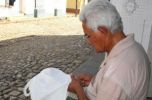 Although it is not possible to determine when Trinidad male residents got first interested in unraveling works, it can be affirmed that it was not long ago.
Although it is not possible to determine when Trinidad male residents got first interested in unraveling works, it can be affirmed that it was not long ago.
By Carlos Luis Sotolongo Ruiz*
Those interviewed represent a group of over-a-dozen men artisans already involved in the job, and most of them lack a relative male predecessor in the practice.
“I was still serving as a pediatrician when I noticed that the selling of my wife’s handmade products was a great contribution to our incomes”, said Carlos Ribalta Martinez. “So, I began to combine my medical profession with what she did”, he added.
Army graduate Andres Perez Mursuli explained that once he concluded his military duties, he found himself in need of supporting the family economy. So, he learned to do randa works with his sister-in-law. He confessed that it was somewhat awkward at first, but people got used to see him do the job and he even began to exchange designs and ideas with several local female artisans.
Osmel Guevara Perez confessed that he found the practice quite odd. But one day he was tempted to try, and he’s been doing the same for over seven years now. He’s got a permanent job himself, but he cannot get away from handiwork anymore.
In the beginning, those men hide themselves inside their homes to avoid curious looks, but they gradually got rid of the fear to be seen by others than their close relatives. Fortunately, “randa men” are more every day, a fact that helps Trinidad’s heritage keep alive.
* Journalism student
 Escambray ENGLISH EDITION
Escambray ENGLISH EDITION





Escambray reserves the right to publish comments.